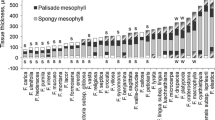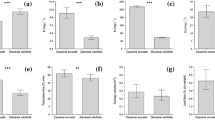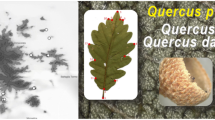Abstract
Leafminer (Phyllonorycter, Gracillariidae, Lepidoptera) and aphid (Tuberculatus, Aphididae, Hemiptera) composition were studied in three deciduous oak species, Quercus dentata, Q. crispula, and Q. serrata, and their hybrids in Tomakomai Experimental Forest of Hokkaido University, Hokkaido, northern Japan. Identification of trees in this forest was done mainly on the basis of discriminant analysis on leaf morphology with reference to trees in pure Q. dentata and Q. crispula stands and a Q. serrata stand mixed with Q. crispula. The results suggested that hybridization occurred in all combinations (i.e. Q. dentata–Q. crispula, Q. crispula–Q. serrata, and Q. serrata–Q. dentata) and the frequency of hybrids was approximately 10%. The composition of Phyllonorycter and Tuberculatus species differed between Q. dentata and Q. crispula or Q. serrata, but did not differ between Q. crispula and Q. serrata. Thus, Q. dentata could differ from Q. crispula and Q. serrata in chemical properties that determine herbivore host selection, survival, and performance, possibly reflecting eco-physiological differences or phylogenetic distances. The study insects were divided into three groups: species specialized to Q. dentata (three Phyllonorycter and one Tuberculatus species), those to Q. crispula and Q. serrata (six Phyllonorycter and two Tuberculatus species), and a species collected at least from Q. dentata and Q. crispula (one Tuberculatus species). Putative hybrid trees of Q. dentata and Q. crispula harbored both Q. dentata-specific and Q. crispula-specific insects.


Similar content being viewed by others
References
Abe Y (1986) Taxonomic status of the Andricus mukaigawae complex and its speciation with geographic parthenogenesis (Hymenoptera: Cynipidae). Appl Entomol Zool 21:436–447
Abe Y (1988) Two host races in Andricus mukaigawae (Mukaigawa) (Hymenoptera: Cynipidae). Appl Entomol Zool 23:381–387
Abe Y (1998) Karyotype differences and speciation in the gall wasp Andricus mukaigawae (s. lat.) (Hymenoptera: Cynipidae), with description of the new species A. kashiwaphilus. Entomol Scand 29:131–135
Aguilar JM, Boecklen WJ (1992) Patterns of herbivory in the Quercus grisea × Quercus gambelii species complex. Oikos 64:498–504
Anderson E (1949) Introgressive hybridization. Wiley, New York
Arnold ML (1997) Natural hybridization and evolution. Oxford University Press, New York
Arnold ML, Hodges SA (1995) Are natural hybrids fit or unfit relative to their parents? Trends Ecol Evol 10:67–71
Boecklen WJ, Spellenberg R (1990) Structure of herbivore communities in two oak (Quercus spp.) hybrid zones. Oecologia 85:92–100
Bruschi P, Vendramin GG, Bussotti F, Grossoni P (2000) Morphological and molecular differentiation between Quercus petrea (Matt.) Liebl. and Quercus pubescence Willd. (Fagaceae) in northern and central Italy. Ann Bot 85:325–333
Burger WC (1975) The species concept in Quercus. Taxon 24:45–50
Coley PD, Bryant JP, Chapin T (1985) Resource availability and plant antiherbivore defense. Science 230:895–899
Craft KJ, Ashley MV, Koenig WD (2002) Limited hybridization between Quercus lobata and Quercus douglasii (Fagaceae) in a mixed stand in central coastal California. Am J Bot 89:1792–1798
Ehrlich PR, Raven PH (1964) Butterflies and plants, a study in coevolution. Evolution 18:586–608
Feeny P (1975) Biochemical coevolution between plants and their insect herbivores. In: Gilbert LE, Raven PH (eds) Coevolution of animals and plants. University of Texas Press, Austin, pp 3–19
Floate KD, Whitham TG (1993) The “hybrid bridge” hypothesis: host shifting via plant hybrid swarms. Am Nat 141:651–662
Fritz RS, Nichols-Orians CM, Brunsfeld SJ (1994) Interspecific hybridization of plants and resistance to herbivores: hypotheses, genetics, and variable responses in a diverse herbivore community. Oecologia 97:106–117
Fujihara J, Sato H, Kumata T (2000) The pupal cremasters as a diagnostic character for species of Phyllonorycter (Lepidoptera: Gracillariidae), with description of a new species of the nipponicella complex from Japan. Insect Syst Evol 31:387–400
González-Rodríguez A, Arias DM, Oyama K (2005) Genetic variation and differentiation of populations within the Quercus affinis–Quercus laurina (Fagaceae) complex analysed with RAPD markers. Can J Bot 83:155–162
Hashizume H, Suo Z, Lee JH, Okada S, Yamamoto F (1994) Fundamental studies on the breeding of Quercus species (II): on the characters of leaves and fruits in natural hybrids among Q. dentata, Q. serrata and Q. mongolica var. grosseserrata. Monogr Collect Jpn For Soc 105:325–328 (in Japanese)
Hattori K, Ishida TA, Miki K, Suzuki M, Kimura MT (2004) Differences in response to simulated herbivory between Quercus crispula and Quercus dentata. Ecol Res 19:323–329
Higuchi H (1969) A revision of the genus Tuberculatus Mordwilko in Japan with description of a new species. Insecta Matsumurana 32:111–123
Himrane H, Camarero JJ, Gil-Pelegrín E (2004) Morphological and ecophysiological variation of the hybrid oak Quercus subpyrenaica (Q. faginea × Q. pubescens). Tree 18:566–575
Howard DJ, Preszler W, Williams J, Fenchel S, Boecklen W (1997) How discrete are oak species? Insights from a hybrid zone between Quercus grisea and Quercus gambelii. Evolution 51:747–755
Huang C, Zhang Y, Bartholomew B (1999) Fagaceae. In: Wu ZY, Paven PH (eds) Flora of China, vol 4. Science Press. Beijing, and Missouri Botanical Garden Press, St Louis, pp 314–400
Igarashi Y (1978) Vegetational succession in the Tomakomai Experiment Forest area. Res Bull Collect Exp For Hokkaido Univ 44:405–427 (in Japanese)
Ishida TA, Hattori K, Sato H, Kimura MT (2003) Differentiation and hybridization between Quercus crispula and Q. dentata (Fagaceae): insights from morphological traits, amplified fragment length polymorphism markers, and leafminer composition. Am J Bot 90:769–776
Ishida TA, Hattori K, Kimura MT (2004) Abundance of leafminers and leaf area loss by chewing herbivores in hybrids between Quercus crispula and Quercus dentata. Can J For Res 34:2501–2507
Jiggins CD, Mallet J (2000) Bimodal hybrid zone and speciation. Trends Ecol Evol 15:250–252
Kanazashi A, Kanazashi T, Kawahara T (1997) Evidence of reproductive barrier between closely related species of Quercus. In: Steiner KC (ed) Proceedings of the conference on diversity and adaptation in oak species. Pennsylvania State University, Philadelphia, p. 243
Kanno M, Yokoyama J, Suyama Y, Ohyama M, Itoh T, Suzuki M (2004) Geographical distribution of two haplotypes of chloroplast DNA in four oak species (Quercus) in Japan. J Plant Res 117:311–317
Kitamura M, Nakamura T, Hattori K, Ishida TA, Shibata S, Sato H, Kimura MT (2007) Among-tree variation in leaf traits and herbivore attacks in a deciduous oak, Quercus dentata. Scand J For Res 22:211–218
Kleinschmit JRG, Bacilieri R, Kremer A, Roloff A (1995) Comparison of morphological and genetic traits of pedunculate oak (Q. robur L.) and sessile oak (Q. petrea (Matt.) Liebl.). Silvae Genet 44:5–6
Lee JH, Hashizume H, Watanabe A, Fukuda T, Shiraishi S, Yamamoto F (1997) RAPD variation among Quercus species distributed in temperate deciduous forests of the Hiruzen Mountains. J For Res 2:121–123
Matsuda K (1996) Autecology of Quercus serrata. In: Kameyama A (ed) Vegetation management of coppice: its ecosystem and management technology. Soft Science Inc, Tokyo, pp 69–77
Matsumoto A, Kawahara T, Kanazashi A, Yoshimaru H, Takahashi M, Tsumura Y (2009) Differentiation of three closely related Japanese oak species and detection of interspecific hybrids using AFLP markers. Botany 87:145–153
Migita C, Chiba Y, Tange T (2007) Seasonal and spatial variations in leaf nitrogen content and resorption in a Quercus serrata canopy. Tree Physiol 27:63–70
Mishima T, Taniguchi S, Taniguchi M (1955) The actual states of wind damage in the Tomakomai Experiment Forest of Hokkaido University (1); on the plantation of strange land species. Res Bull Collect Exp For Hokkaido Univ 17:715–748 (in Japanese)
Mishima T, Taniguchi S, Taniguchi M, Hishinuma Y (1958) The actual states of wind damage in the Tomakomai Experiment Forest of Hokkaido University (2); on the natural forest. Res Bull Collect Exp For Hokkaido Univ 19:1–39 (in Japanese)
Muir G, Fleming CC, Schlötterer C (2000) Species status of hybridizing oaks. Nature 405:1016
Nabeshima E, Murakami M, Hiura T (2001) Effects of herbivory and light conditions on induced defense in Quercus crispula. J Plant Res 114:403–409
Ohba H (1989) Fagaceae. In: Satake Y, Hara H, Watari S, Tominari T (eds) Wild flowers of Japan: woody plants, vol 1. Heibonsha, Tokyo, pp 66–78 (in Japanese)
Okaura T, Quang ND, Ubukata M, Harada K (2007) Phylogeographic structure and late Quaternary population history of the Japanese oak Quercus mongolica var. crispula and related species revealed by chloroplast DNA variation. Genes Genet Syst 82:465–477
Quednau FW (1999) Atlas of the drepanosiphine aphids of the world. Part I: Panaphidini Oestlund, 1922—Myzocallidina Börner, 1942 (1930) (Hemiptera: Aphididae: Calaphidinae). Contr Am Entomol Inst 31:1–281
Rieseberg LH (1995) The role of hybridization in evolution: old wine in new skins. Am J Bot 82:944–953
Sage RD, Heyneman D, Lim KC, Wilson AC (1986) Wormy mice in a hybrid zone. Nature 324:60–63
Sato H (1991) Differential resource utilization and co-occurrence of leaf miners on oak (Quercus dentata). Ecol Entomol 16:105–113
Sato H, Okabayashi Y, Kamijo K (2002) Structure and function of parasitoid assemblages associated with Phyllonorycter leafminers (Lepidoptera: Gracillariidae) on deciduous oaks in Japan. Environ Entomol 31:1052–1061
Schoonhoven LM, Jermy T, van Loon JJA (1998) Insect–plant biology. Chapman & Hall, London
Shibata S, Ishida TA, Soeya F, Morino N, Yoshida K, Sato H, Kimura MT (2001) Within-tree variation in density and survival of leafminers on oak Quercus dentata. Ecol Res 16:135–143
Strong DR, Lawton JH, Southwood TRE (1984) Insects on plants. Community patterns and mechanisms. Blackwell, Oxford
Thompson JN (1994) The coevolutionary process. University Chicago Press, Chicago
Tomlinson PT, Jensen RJ, Hancock JF (2000) Do whole tree silvic characters indicate hybridization in red oak (Quercus Section Lobatae)? Am Midl Nat 143:154–168
Tovar-Sánchez E, Oyama K (2004) Natural hybridization and hybrid zones between Quercus crassifolia and Quercus crassipes (Fagacae) in Mexico: morphological and molecular evidence. Am J Bot 91:1352–1363
Tovar-Sánchez E, Oyama K (2006) Effect of hybridization of the Quercus crassifolia × Quercus crassipes complex on the community structure of endophagous insects. Oecologia 147:702–713
Ubukata M, Itahana N, Kohono N (1999) Cross-compatibility between Quercus mongolica var. grosseserrata and Q. dentata and both the reproductive ability and flowering time of their interspecific hybrids. J Jpn For Soc 81:286–290 (In Japanese with English summary)
Van Valen L (1976) Ecological species, multispecies, and oaks. Taxon 25:233–239
Wada N, Murakami M, Yoshida K (2000) Effects of herbivore-bearing adult trees of the oak Quercus crispula on the survival of their seedlings. Ecol Res 15:219–227
Whitham TG (1989) Plant hybrid zones as sinks for pests. Science 24:1490–1493
Williams JH, Boecklen WJ, Howard DJ (2001) Reproductive processes in two oak (Quercus) contact zones with different levels of hybridization. Heredity 87:680–690
Yoshida K (1985) Seasonal population trends of macrolepidopterous larvae on oak trees in Hokkaido, northern Japan. Kontyû 53:125–133
Acknowledgments
We thank Y. Murata, T. Shindo, F. Nomano, and S. Furihata for their assistance in field work. This work was partly supported by a Grant-in-Aid from the Ministry of Education, Science, Sports and Culture of Japan (no. 15207008).
Author information
Authors and Affiliations
Corresponding author
About this article
Cite this article
Hata, Y., Hashiba, T., Nakamura, T. et al. Differences in leafminer (Phyllonorycter, Gracillariidae, Lepidoptera) and aphid (Tuberculatus, Aphididae, Hemiptera) composition among Quercus dentata, Q. crispula, Q. serrata, and their hybrids. J For Res 16, 309–318 (2011). https://doi.org/10.1007/s10310-010-0230-9
Received:
Accepted:
Published:
Issue Date:
DOI: https://doi.org/10.1007/s10310-010-0230-9




